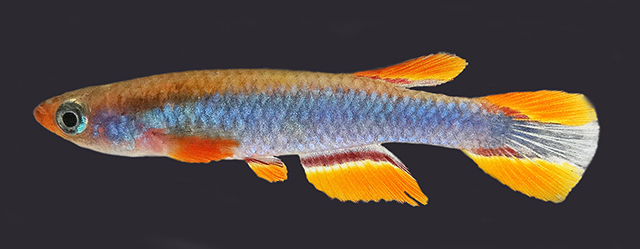|
Dorsal spines (total): 0-0; Dorsal soft rays (total): 9-12; Anal spines: 0-0; Anal soft rays: 14-16. Diagnosis: Males of Aphyosemion cryptum are distinguished from all other Aphyosemion, except for A. coeleste, by its unique combination of colouration characters in males: a light blue body with a few red markings on flanks and caudal peduncle; yellow to orange on distal part of unpaired fins; base of dorsal and anal fins blue, distally followed by a red band, two parallel or converging red lines along the blue centre of caudal fin; at least in anal and ventral part of caudal fin between red band and yellow to orange distal parts a narrow white line; by mitochondrial DNA results and male colour pattern it clearly belongs to the A. coeleste group (Ref. 125647). It differs from A. coeleste by the lack of a green or yellow iridescent blotch posterior to the operculum; in A. coeleste three to four less regular rows of red spots on anterior part of side within the green or yellow blotch vs. rows of red spots absent or reduced to a few irregular spots in A. cryptum (Ref. 125647). Description: Dorsal profile slightly convex, greatest body depth at base of pelvic fin, ventral profile slitghtly convex, caudal peduncle dorsally and ventrally concave; snout rounded, mouth directed upwards, lower jaw longer than upper jaw, posterior end of rictus at level of dorsal third of eye (Ref. 125647). Frontal neuromasts in two separate grooves, pre-opercular, pre- and post-orbital system with tubular canals; two supra-orbital grooves, 12.1-13.1% of inter-orbital width, with three neuromasts each (Ref. 125647). Teeth on jaws unicuspid, outer row large and inward curved, inner teeth smaller and more irregularly placed (Ref. 125647). Scales cycloid, body completely scaled except ventral head surface; frontal squamation of G-type; no scales on dorsal and anal fin base; two to three scale rows on caudal fin base; scales on mid longitudinal series 30-32; transverse series of scales before dorsal fin 9; circumpeduncular scale row 14 (Ref. 125647). All unpaired fins rounded in males, adult males have no elongated rays at caudal fin edges; number of dorsal-fin rays 9-12, anal fin rays 14-16; first dorsal fin ray above anal fin ray 7-8; pectoral fin not reaching pelvic fin, pelvic fin not reaching anal fin (Ref. 125647). Colouration: Live colouration of males: body on side blue, only anteriorly some irregular red spots, in some populations these spots are completely absent; ventrally light blue to greyish, dorsally brown; snout yellow; up to three red streaks on operculum in an approximate 45° angle, however, in most populations reduced or completely absent; anal, dorsal, and pelvic fin distally yellow to orange, with red band above narrow blue base, sometimes with light blue narrow edge; caudal fin dorsally and ventrally yellow to orange, separated from the blue fin centre by two parallel or converging red bands; red band in fins distally often followed by narrow white line; pectoral fin yellow to orange (Ref. 125647). Live colouration of females: body light brown to grey-brownish, dorsally darker and ventrally light brown; scales on sides, especially on dorsal part and on caudal peduncle, with dark border, forming reticulated pattern; most scales on dorsal half of sides with small red dot at transition of two scales; dorsal fin hyaline with inter-radial red streaks, sometimes spotted at base, anal fin hyaline with inter-radial reddish-grey streaks, caudal fin hyaline, unspotted, pelvic and pectoral fins hyaline, unspotted (Ref. 125647). Colouration in 70% ethanol of males: body dark grey, ventrally lighter from pelvic fins to ventral part of head and throat; chin and lips light grey; dorsal, anal, and pelvic fin whitish with red band at the base; caudal fin whitish with dark grey central part, edged with red bands; pectoral fin whitish (Ref. 125647). Colouration in 70% ethanol of females: dorsal part of flanks grey-brown with gradual transition to lighter ventral side; all scales with dark border, especially on the caudal peduncle; pelvic and pectoral fin grey; dorsal fin with inter-radial red streaks, anal and caudal fin grey with inter-radial dark grey pigmentation (Ref. 125647). |

